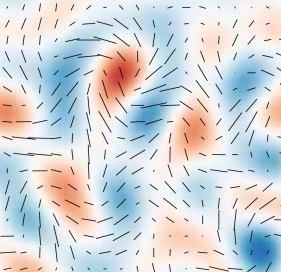
Most of us have encountered some of the ideas behind the theory of our universe's origins called the Big Bang. Astronomers can detect and measure how galaxies are rapidly moving away from each other today. If you run this movie backwards in time using a bit of mathematics, you find that 13.8 billion years ago, the universe was unimaginably hot and dense. Running this movie forward in time, space expands and cosmic matter becomes less dense and colder.
CMB polarization and G-modes
By 300,000 years after the Big Bang, the temperature has chilled to 3,000 degrees Celsius. Because the hydrogen gas that makes up the universe is so cold, it no longer reacts with the cosmic-fireball light left over from the Big Bang. It is like a pea-soup fog has lifted from space. Light is able to travel trillions of kilometers unaffected by matter. This is what astronomers call the cosmic background radiation, or CMB, and it is detected at radio wavelengths. Today it has cooled to a temperature of -270 degrees Celsius (2.7 Kelvin), just above absolute zero. This temperature and the brightness of the CMB is very uniform across the entire sky, to an astonishing one part in 100,000!
The CMB uniformity turns out to be a big problem for the Big Bang theory. It should not be smooth across the sky at all! The light energy that should have smoothed out the temperature of matter in space has not yet traveled across the entire sky as we see it today. Areas of the sky farther apart than a few times the full moon should show very different temperatures. Big Bang theory v. 1.0 could never explain this smoothness problem.
Inflationary Cosmology to the Rescue!
While astronomers were puzzling over the CMB's smoothness, physicists were busy putting together a better theory of how matter and forces work. They were trying to unify the electromagnetic and weak forces with the strong nuclear force so that only one mathematical description was needed to describe the whole shebang. It was called "grand unified theory" (GUT). To make it work, it was pretty much agreed that you had to add new kinds of fields to space to make the forces and particles look as different as they do. These new "scalar" fields would be a new property of empty space that all matter and forces had to operate within, like fleas swimming in some invisible molasses.
Some of the best candidate GUTs also predicted the existence of new unobserved particles called magnetic monopoles. To do away with these particles, physicist Alan Guth at MIT looked at the basic Big Bang equations and discovered that adding one of these scalar fields to space would expand space at an exponential pace as the Big Bang happened. Today the nasty little monopoles would be billions of light years apart and not detectable. This was heralded as "inflationary cosmology," and in an amazing trifecta it also did away with the problem of the CMB's smoothness and uniform temperature. Here's how!
Before inflation, space had been expanding at a slower pace like the elastic membrane on a balloon. The "inflaton field," as it came to be called, was still hidden in the fabric of space, like the red color on the balloon. But just as water cools to ice, once the universe had cooled enough, the inflaton field changed its state to a lower-energy one, just as ice contains less energy than water. In our balloon analogy, the color changed from red to an invisible transparency! During this phase change, the inflaton field caused space to expand exponentially fast, doubling the separation between matter particles every trillion-trillion-trillionth of a second or so. After a few thousand of these doublings, the phase change ended and inflationary expansion stopped. The enormous latent energy stored in the inflaton field had been dumped into the creation of very massive particles. These new particles condensed out of space like rain drops and quickly decayed to form the cosmic fireball radiation and the much lighter elementary particles we see around us today.
This inflationary era began one trillion-trillion-trillionth of a second after the Big Bang. Before then, the amount of space in the "infinite" universe was still vast. But at an enormously small scale, matter and energy were spread out in space in a very lumpy manner dictated by the laws of quantum mechanics. Inside each lump the conditions were very smooth, but neighboring lumps had very different temperatures and physical properties -- perhaps even different laws of physics!
After inflation, one of these lumps grew in size by trillions of times. We are living inside a very small portion of one of these original lumps of space and energy. By some estimates, all of the universe we now see is only one millionth of the volume of the lump we descended from before inflation. No matter where we look, we will always see the CMB at nearly the same temperature across the entire sky. But it raises the question of what to make of these vastly more distant neighbor patches we will never be able to visit or see. Some call this entire carpet of patches the multiverse.
What is exciting about the recent discovery of "gravity B-modes" is that the inflationary era would have been awash with waves of gravity due to the extreme violence of the events at that time. These gravity waves would have imprinted themselves in the way the CMB was first formed during this era. Like a fingerprint in the sky, astronomers can now detect the signs of this radiation for the first time! Its discovery is a confirmation of inflationary cosmology and also of the existence of gravity waves, which were long ago predicted by Einstein's theory of general relativity!
By the way, the inflaton field has a modern cousin called "dark energy," which is causing the expansion of the universe to accelerate today. Oh, my!
